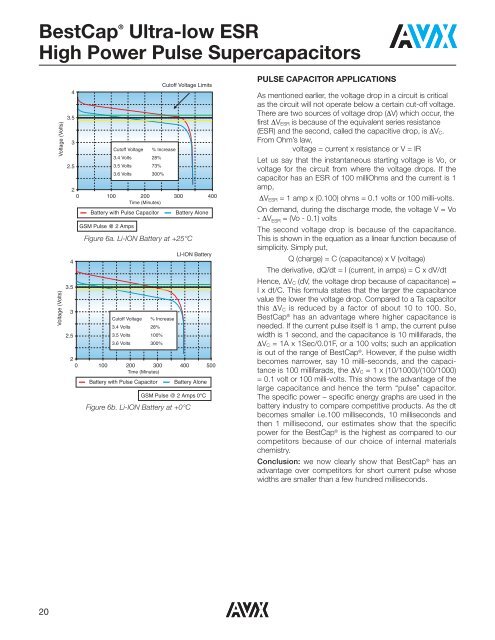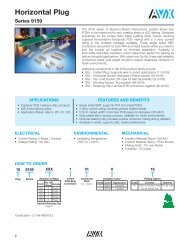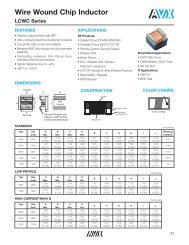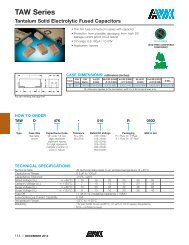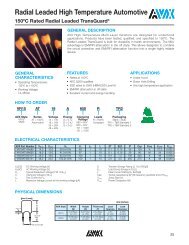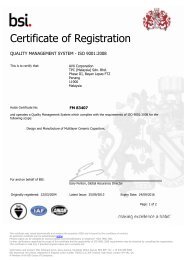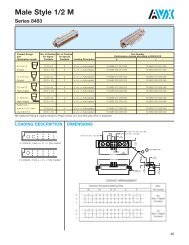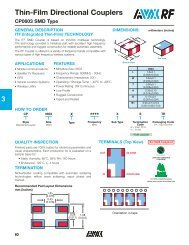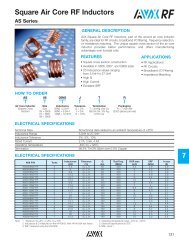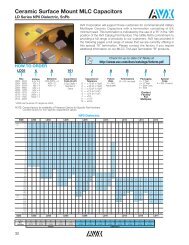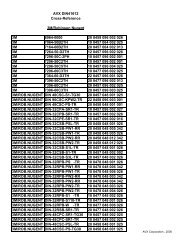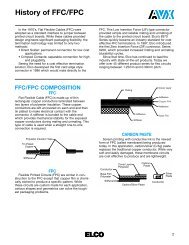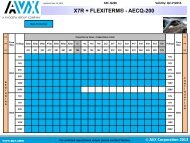BestCap Ultra Low ESR Supercapacitor - AVX
BestCap Ultra Low ESR Supercapacitor - AVX
BestCap Ultra Low ESR Supercapacitor - AVX
Create successful ePaper yourself
Turn your PDF publications into a flip-book with our unique Google optimized e-Paper software.
<strong>BestCap</strong> ®<br />
<strong>Ultra</strong>-low <strong>ESR</strong><br />
High Power Pulse <strong>Supercapacitor</strong>s<br />
Voltage (Volts)<br />
Voltage (Volts)<br />
Cutoff Voltage Limits<br />
4<br />
3.5<br />
3<br />
Cutoff Voltage % Increase<br />
3.4 Volts 28%<br />
2.5<br />
3.5 Volts 73%<br />
3.6 Volts 300%<br />
2<br />
0 100 200 300 400<br />
Time (Minutes)<br />
4<br />
3.5<br />
3<br />
2.5<br />
Battery with Pulse Capacitor Battery Alone<br />
GSM Pulse @ 2 Amps<br />
Figure 6a. Li-ION Battery at +25°C<br />
LI-ION Battery<br />
Cutoff Voltage % Increase<br />
3.4 Volts 28%<br />
3.5 Volts 100%<br />
3.6 Volts 300%<br />
2<br />
0 100 200 300 400 500<br />
Time (Minutes)<br />
Battery with Pulse Capacitor Battery Alone<br />
GSM Pulse @ 2 Amps 0°C<br />
Figure 6b. Li-ION Battery at +0°C<br />
PULSE CAPACITOR APPLICATIONS<br />
As mentioned earlier, the voltage drop in a circuit is critical<br />
as the circuit will not operate below a certain cut-off voltage.<br />
There are two sources of voltage drop (ΔV) which occur, the<br />
first ΔV <strong>ESR</strong> is because of the equivalent series resistance<br />
(<strong>ESR</strong>) and the second, called the capacitive drop, is ΔV C .<br />
From Ohm’s law,<br />
voltage = current x resistance or V = IR<br />
Let us say that the instantaneous starting voltage is Vo, or<br />
voltage for the circuit from where the voltage drops. If the<br />
capacitor has an <strong>ESR</strong> of 100 milliOhms and the current is 1<br />
amp,<br />
ΔV <strong>ESR</strong> = 1 amp x (0.100) ohms = 0.1 volts or 100 milli-volts.<br />
On demand, during the discharge mode, the voltage V = Vo<br />
- ΔV <strong>ESR</strong> = (Vo - 0.1) volts<br />
The second voltage drop is because of the capacitance.<br />
This is shown in the equation as a linear function because of<br />
simplicity. Simply put,<br />
Q (charge) = C (capacitance) x V (voltage)<br />
The derivative, dQ/dt = I (current, in amps) = C x dV/dt<br />
Hence, ΔV C (dV, the voltage drop because of capacitance) =<br />
I x dt/C. This formula states that the larger the capacitance<br />
value the lower the voltage drop. Compared to a Ta capacitor<br />
this ΔV C is reduced by a factor of about 10 to 100. So,<br />
<strong>BestCap</strong> ® has an advantage where higher capacitance is<br />
needed. If the current pulse itself is 1 amp, the current pulse<br />
width is 1 second, and the capacitance is 10 millifarads, the<br />
ΔV C = 1A x 1Sec/0.01F, or a 100 volts; such an application<br />
is out of the range of <strong>BestCap</strong> ® . However, if the pulse width<br />
becomes narrower, say 10 milli-seconds, and the capacitance<br />
is 100 millifarads, the ΔV C = 1 x (10/1000)/(100/1000)<br />
= 0.1 volt or 100 milli-volts. This shows the advantage of the<br />
large capacitance and hence the term “pulse” capacitor.<br />
The specific power – specific energy graphs are used in the<br />
battery industry to compare competitive products. As the dt<br />
becomes smaller i.e.100 milliseconds, 10 milliseconds and<br />
then 1 millisecond, our estimates show that the specific<br />
power for the <strong>BestCap</strong> ® is the highest as compared to our<br />
competitors because of our choice of internal materials<br />
chemistry.<br />
Conclusion: we now clearly show that <strong>BestCap</strong> ® has an<br />
advantage over competitors for short current pulse whose<br />
widths are smaller than a few hundred milliseconds.<br />
20


